Making Black and Whites
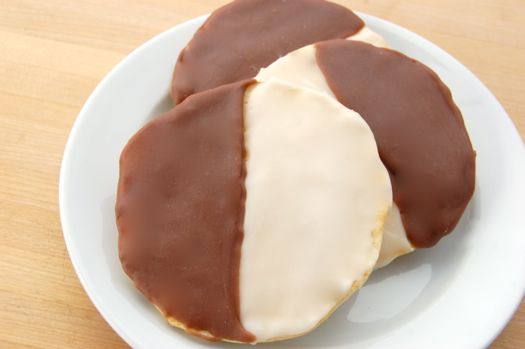
Repeat after me: black and whites are cakes, black and whites are cakes, black and whites are cakes. Got that? Whew! Now maybe the New Yorkers will get off my back and let me eat my cookies in peace!
These aren’t difficult once you have the fondant in hand, and I do recommend making actual poured fondant since the effect is much creamier than with simple sugar-and-water icing. Something about the way the smooth fondant melds together with the hint of lemon in the cake…it really makes these. Indeed the classic versions are much more interesting than the newfangled jobs made with real chocolate coatings or rich frostings. These, in my opinion, are the Cadillacs.
Start by assembling your ingredients and preheating your oven to 350 degrees Fahrenheit. Start the batter by sifting your flours together in a medium bowl.
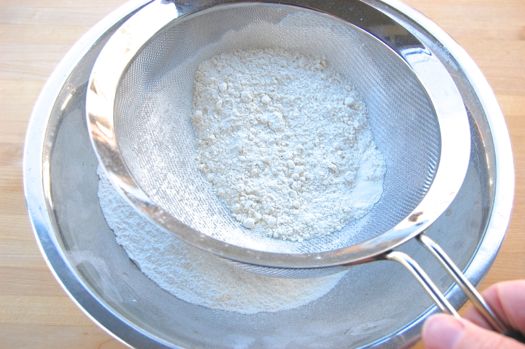
Add the salt, baking powder and lemon zest…
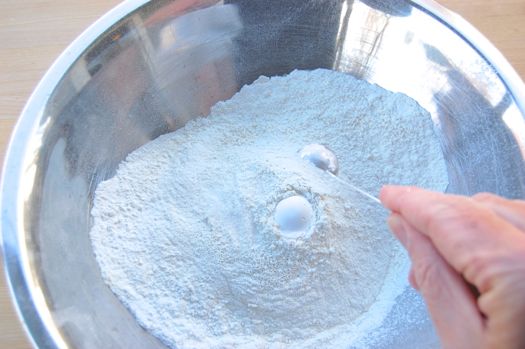
…and whisk everything together.
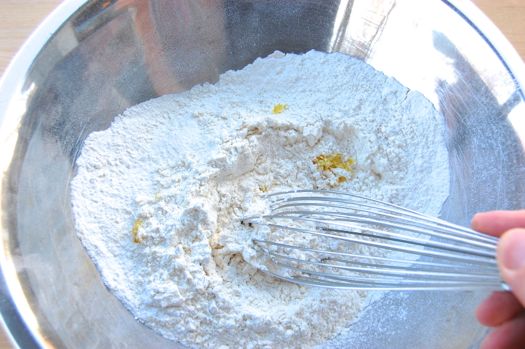
Now combine the sugar and butter in the bowl of your mixer.

Cream them together until they’re fluffy and then beat in the eggs one by one, for about 15 seconds each.
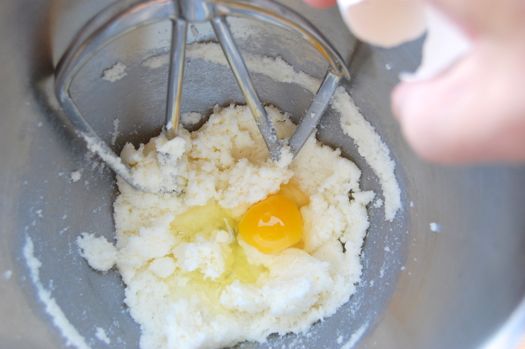
Scrape that bowl and beat the mixture about 20 seconds until it’s very light. Scrape.
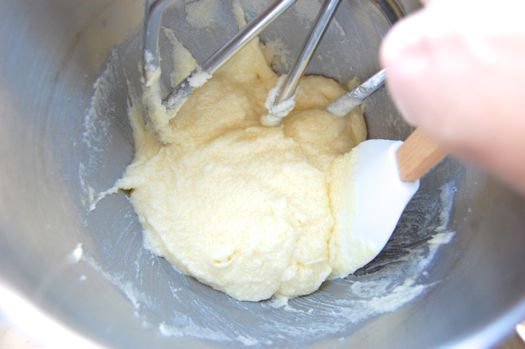
Now add a third of the flour…
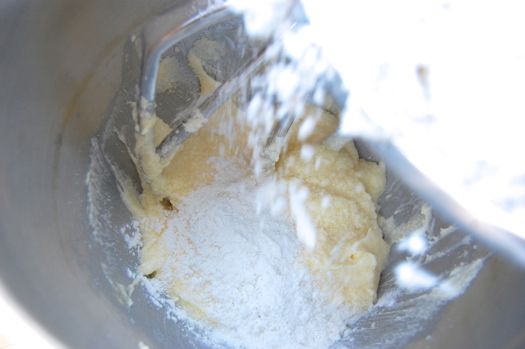
…followed by half the milk-vanilla mixture, and continue like that until everything is incorporated.
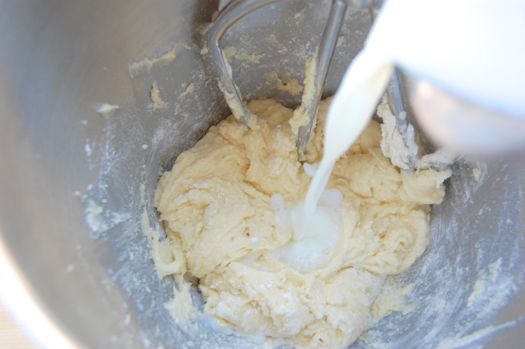
Don’t forget to scrape!
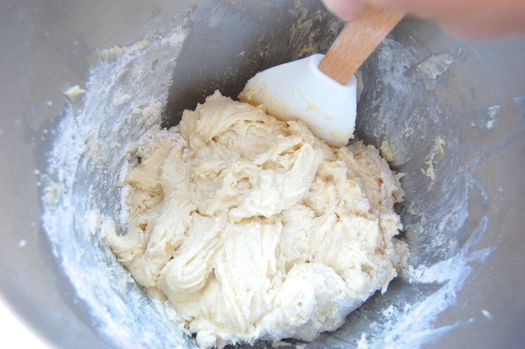
Apply dollops of the batter to two parchment paper-covered sheet pans, six on each one. Make them as round as you can.
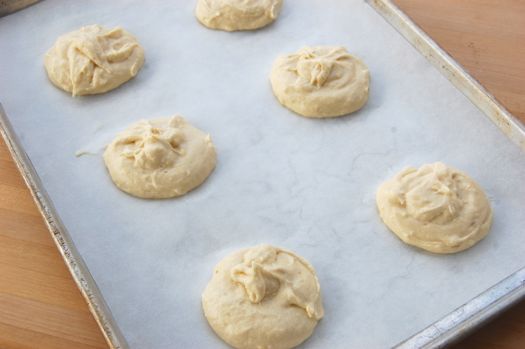
Bake them for ten minutes, rotate the pans, and bake another ten. They’ll spread out and look quite blonde, but that’s what you want.
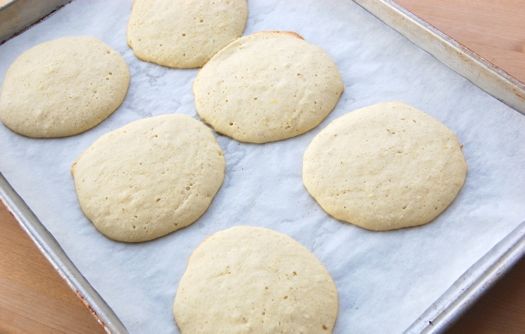
Why? Because you don’t want the caramelized bottoms to show through the icing, at least the vanilla side. Below is as dark as you want to let them get on the bottoms. Allow the cakes to cool completely.
Meanwhile put a batch of white fondant in the top portion of a double boiler, melt it over simmering water. Spike it with a teaspoon of vanilla and thin it with about two teaspoons of water until it runs like light cream. It’s easiest to work right over the pan of warm fondant.

You want to ice the cakes on one side with vanilla of course. Here I used an icing spatula, though I quickly realized this wasn’t the best way to get a smooth coat. Better, I determined, to hold the cake over the pan, tilt the flat face toward me, and spoon the fondant onto them, letting it run down one side. The fondant should be thick enough so that coats, but not so thick that it firms up before you can go back for a quick patch-up if you don’t get whole side in one go. If you’re getting bumps or clumps, or it’s firming before it even runs off the cake, add another teaspoon or so of water.
I apologize for not showing this but it was too involved an operation to photograph with one hand, especially in cool air. You’ll have to let your imagination run wild with this one, K?
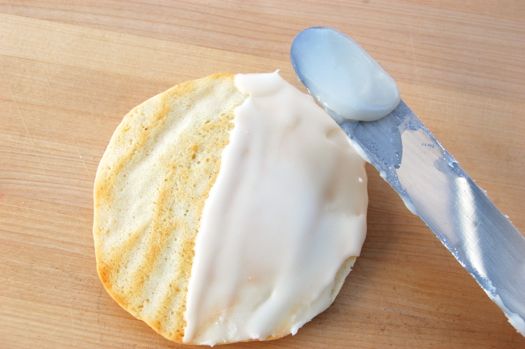
Anyway, do all the vanilla sides first and set them aside to cool. Meanwhile melt another batch of white fondant on the double boiler and stir in a tablespoon or two of cocoa powder. The darker the cocoa the blacker the black and white. Repeat the operation on the un-iced sides of the cakes.
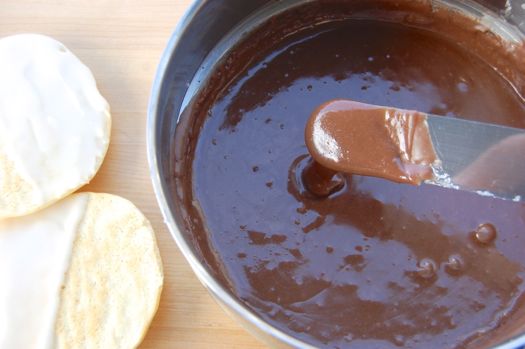
And that’s all there is to that, really.
Those look authentic! A lot of recipes call for a simple confectioner’s sugar glaze, which may be close, but no cigar (as my New York parents would say.)
I’ll try these after Passover, when regular cake will be back on the menu.
Thanks, Laurie! They’re definitely not world class in their appearance, but they sure taste great. Let me know what you think of them!
– Joe
Definitely one for the “to bake list” -thanks for the post – I’ll be interested to compare the overall taste with Neenish Tarts, can’t help thinking there’s a link 🙂
You’re probably right about that, Heather. Somehow…somewhere…
Let me know how they turn out!
– Joe
I know that the bottom isn’t traditionally iced, but I’m wondering if that would work – dip halfway into the vanilla, back on parchment paper and into the fridge (for firming up of the vanilla side)… then later dipping into the chocolate side the same way.
Probably would leave the kids with very messy fingers while eating though….
I have seen some hand-dipped black and whites, but to me that puts on too much icing. I may try these again before I move on to something else, since I’m not entirely satisfied with the look. Taste yes, look no!
– Joe
Hey Roger!
The spoon-over method is really the easiest, I’ve determined, and it’s really fast as well. I practiced a little over the weekend and the improvement was noticeable. Check the “Second Try” post that I just put up…the finish was a lot better this time.
– Joe
Those look great! I am very impressed. I think it is high-time I gave these a try. What is your cake like? Light? Dense? I’m looking forward to trying the fondant, I’ve never done that. It will all have to be after Passover, but this is now definitely on the agenda.
Last week I went to a NY bakery and bought a mini red-velvet black and white. I don’t know what got into me. It was quite awful, both as a cake and as anything even remotely resembling a black and white, which it didn’t. (But at least they didn’t call it a cookie!!)
And the correct way to eat them, of course, is to keep the chocolate half for yourself and give the vanilla half to your little sister, because what does she know?
Thanks, Chana! They improved markedly the second time I attempted the finish. The cake is an in-between methinks in terms of texture. The first time I tried it the crumb came out fluffy, which just didn’t seem right. The next was chewy and this latest one is just right….at least to me. I’d be curious to know what a lifelong B&W eater thinks. And the fondant is quite easy. Try it!
– Joe
When I lived in NYS we always called them cookies.
And no one ever threw rocks at you?
– Joe
When I grew up in Germany these cakes were called: Amerikaner. According to German Wiki they got their name from the ingredient ammonium bicarbonate, the were Ammoniumkekse and then turned into the easier to pronounce Amerikaner :). Supposedly there are cook books dated before World War II with recepies for them. I don’t know if this is correct but I thought it was interesting. Now our bakery only made them with vanilla icing, so I was never interested in them. With one half chocolate though I might give them a try
Hi Franziska!
I intended to mention that during the week. I looked around for an explanation but couldn’t find one. I appreciate yours, whether it’s accurate or not it’s interesting. Thanks for checking in!
– Joe
I made them; followed your recipe exactly and lo and behold, they look exactly like the picture! (one-third cup of batter per cake, just as your earlier recipe said).
I think they actually taste a bit better after being wrapped and stored for a couple of days.
That’s part of the aesthetic I think, Wally…a little stale, but also I think the flavors to have a chance to meld a bit more when they sit. You’re very right. Thanks for giving these a try!
– Joe
My favorite authentic Jewish bakery frosts the domed side, and calls them cookies. But this is Los Angeles… what can I say?
Indeed, everything is upside down out there, isn’t it? 😉
Thanks Brian!
– Joe